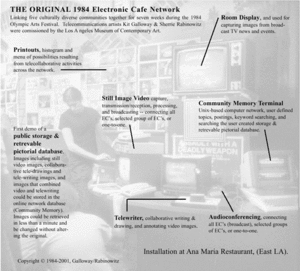1984 - Ecafe Manifesto - Kit Galloway & Sherrie Rabinowitz

Text
ECAFE MANIFESTO.
THE CHALLENGE: WE MUST CREATE AT THE SAME SCALE AS WE CAN DESTROY
If the arts are to take a role in shaping and humanizing emerging technological environments, individuals and arts constituencies must begin to imagine at a much larger scale of creativity.
We must begin to create at the same scale as we can destroy, or else art, and more dangerously the human spirit and imagination, will be rendered decorative and impotent.
If the boundaries between art and life dissolve it will be the result of artists migrating towards a new order of artmaking, abandoning the conventional standards and practices and becoming 'new practitioners' or systems integrators, who produce situations, contexts, and permanent environments or utilities. The 'new practitioners' can begin the process of healing the aesthetic wound that has disfigured the business of Art, and continue the aesthetic quest in more relevant directions.
New creative activities must emerge such as multi-media creative solutions networks, not simply computer networks for Artists, but rather multi-media telecommunications networks with agendas that can engage multi-disciplinary constituencies. This will require the development of new skills and the cultivation of new relationships between the participants. The movement is towards the control of a meaningful context, creating environments not just to support art, but that create the possibility for new scales of creativity across all disciplines and boundaries.
The dark side of the "new world information order" suggests that a new scale aesthetics be created. It will take several years from the time this work begins for creative solutions networks of appropriate number, scale, velocity, and dexterity to evolve to maturity. Consider: co-creating non-imperialistic, multi-cultural or domestic agendas for community or global scale aesthetic endeavors. Consider: the continuous re-invention of non-hierarchical telecom networks that will allow people to bypass cultural gatekeepers and power brokers. We must accept these kinds of challenges and recognize what can be gained by solving them.
All of this implies that there is a new way to be in the world. That the counterforce to the scale of destruction is the scale of communication, and that our legacy or epitaph will be determined in many ways by our ability to creatively employ informal, multi-media, multi-cultural, conversational, telecommunications and information technologies.
Context
This manifesto was conceive as a part of the Electronic Cafe Network Project that was created in 1984 by Kit Galloway and Sherrie Rabinowitz for The Summer Olympics Arts Festival in Los Angeles (United States). The idea was proposed ""a network of new informal institutions to exhibit, find, humanize and acculturate the technologies that change the world" (1) in response to the resultant activities of the orwellian year. The goal was to integrate "the community, the art, the tecnology, the multimedia telecommunications and the transcultural communications. The tecnical mission was to define human basics requirements for facilitate a 'creative conversation' between the people even if they don't speak the same lenguage" (2). The project was available for seven weeks and connected different communities in the metropolitan area of Los Angeles (2). In 1987 the authors realeased Electronic Cafe Internacional (3). In 2001 the project was part of the exhibition Telematic Connections: The Virtual Embrace curated for Steve Dietz whose website retains the Walker Art Center (4).
Authors
Since 1975 Galloway y Sherrie Rabinowitz had been focus their artistic colaboration in the development of new and alternative structures for the interactive communication. Some of their most outstandings works are: Satellite Arts Project (1977), Hole-In-Space (1980) y Electronic Cafe (1984).Both combined the tecnologic and sociological possibilities of the bidirectional communications with the artistic sensitibity to create elegant models of how things could be. These "models", a concept that they prefer instead of "artworks", works not only as a vission of how the telecomunications could serve to the humanity, but also present some provocative notions about the future and the function of the artist (5).
File
File:ECI MANIFESTO FOR 1984.pdf
Sources
(1) http://www.ecafe.com/museum/about_festo/84manifesto.html
(2) http://www.ecafe.com/museum/history/ksoverview2.html
(3) Galloway, K. & Rabinowitz, S. (1992). WELCOME TO "ELECTRONIC CAFE INTERNATIONAL". A NICE PLACE FOR HOT COFFEE, ICED TEA, & VlRTUAL SPACE. En Linda Jacobson (ed.), CyberArts: Exploring Art & Technology. Miller Freeman. Recuperado de: http://www.ecafe.com/museum/cyberart92/Welcome_to_ECI.html
(4) http://telematic.walkerart.org/timeline/timeline_ecafe.html
(5) Durland, S. (1987). Defining the image as place. A conversation with Kit Galloway, Sherrie Rabinowitz & Gene Youngblood. HIGH PERFORMANCE A Quarterly Magazine for the New Art Audience, 37. Recuperado de: http://www.ecafe.com/museum/hp_gy_1987/hp_gy_1987.html
Links
First Edition: http://www.ecafe.com/museum/about_festo/84manifesto.html
URL: http://telematic.walkerart.org/timeline/timeline_ecafe.html
Wayback Machine: http://www.ecafe.com/museum/about_festo/84manifesto.html, https://web.archive.org/web/20180316235052/http://telematic.walkerart.org/timeline/timeline_ecafe.html
